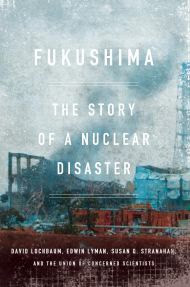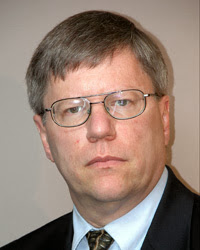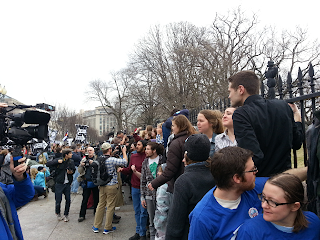On 3rd anniversary of Fukushima, two authors report American reactors are unsafe at any speed. Shocking risk. Plus audio from March 2 XL Pipeline dissent protest in D.C. & letter from youth, via Bobby Wengronowitz. Radio Ecoshock 140312 http://tinyurl.com/lerpc6j
Yes, despite a punishing cold winter, thousands of Americans showed up at the White House to fight off the Keystone XL pipeline. They were mostly young, protecting their future against climate change driven by the Tar Sands, the dirtiest fuel on Earth. Over 350 people were arrested. I'll take you there.
But first, on the third anniversary of the worst nuclear disaster in the world, I'll talk with the authors of Fukushima, The Story of a Nuclear Disaster". But America is just waiting for it's own nuclear mega-disaster. Despite promises after March 2011, the U.S. industry is still stalling on safety critical fixes to aging reactors. It's just a matter of time.
I'm Alex Smith. Welcome back to Radio Ecoshock.
Listen to/download this program in CD Quality or Lo-Fi
THE FUKUSHIMA STORY BLOWS THE COVER ON AMERICAN REACTOR SAFETY
Interview with David Lochbaum, Union of Concerned Scientists
After the triple melt down of reactors in Fukushima Japan in March 2011, the American Nuclear Regulatory Commission did two things: they assured the public "it can't happen here" - and they promised a flurry of action to make reactors safer in the United States.
Now we have the first new book from nuclear experts explaining what happened at Fukushima. And we have a report that American reactors are still unsafe, still waiting for the next major melt-down.
Both come from David Lochbaum. He worked in U.S. reactors for 17 years. He was an instructor for the NRC. David is now Director of the Nuclear Safety Project, for the Union of Concerned Scientists.
Read David's latest article "Nuclear Disaster American Style" here.
Half of reactors in U.S. don't meet fire regulations. This is as dangerous as a risk factor as the tsunami that broke Fukushima.
David writes:
"The Nuclear Regulatory Commission examined fire hazards during a briefing on July 17, 2008. An NRC senior manager informed the Chairman and Commissioners that “Approximately one-half of the core damage risk at operating reactors results from accident sequences that initiate with fire events.” In other words, the fire hazard roughly equals all other hazards combined. And that analysis assumed the NRC’s fire protection regulations were being met—the risk goes up when the fire regulations are not met.
Fire is a large risk for the same reason that flooding caused so much trouble at Fukushima. Fires and floods can disable primary safety systems and their backups. If workers are unable to recover disabled equipment or connect temporary replacements, reactor cores overheat and melt down.
The nuclear plant fire hazard is not speculative. In March 1975, a fire at the Browns Ferry Nuclear Plant in Alabama disabled all the emergency systems for cooling the Unit 1 reactor and most of those systems for Unit 2. Only heroic worker efforts prevented both cores from melting that day.
The NRC did not want another nuclear plant to experience another fire as bad as, or worse than, the one at Browns Ferry. It adopted fire protection regulations in 1980 intended to manage the fire risk to an acceptably low level. In the late 1990s, the NRC’s inspectors discovered that dozens of reactors, including the two at Diablo Canyon, did not satisfy the 1980 fire protection regulations. In 2004, the NRC adopted an alternative set of fire protection regulations. Owners had the choice of satisfying either set of regulations. On December 29, 2005, Diablo Canyon’s owner notified the NRC that it opted to someday implement the measures necessary to achieve compliance with the 2004 regulations. As of today, Diablo Canyon meets neither set of fire protection regulations."
Fully one third of American reactors are not protected against flooding from upstream dam breaking. Another nuclear plant would be in severe danger if a DOWNSTREAM dam broke, because that would drain away the source for it's cooling water.
About one quarter of all American reactors in geologic danger zones are not protected against earth quake hazards.
Get the Executive Summary of the Union of Concerned Scientists report on the NRC and U.S. nuclear safety in 2013 .
After Fukushima, David Lockbaum was on Radio Ecoshock June 1st, 2011. Here is a link to that show blog, and you can listen to/download that interview with David here. It's still important today.
David and co-author Susan Stranahan did an excellent interview for The Real News on American nuke safety. Find that here. Or watch it . They are also featured in this Washington's Blog entry.
You can buy the book "Fukushima: The Story of a Nuclear Disaster" . Or get more details at the Union of Concerned Scientists web site.
In testimony relating to the C-10 group in Boston, and the Pilgrim reactor relicensing, David Lochbaum explained how the NRC stopped enforcing regulations in 1998, after Congress threatened to cut NRC funding. It's incredible how the nuke industry managed to use politicians to avoid spending money on safety fixes.
All this leads to the third big question about American reactor safety. After Fukushima, the Nuclear Regulatory Commission promised to be more vigilant, and get more problems fixed in American reactors. Yet the NRC oversight seems weak, where many safety matters are just voluntary for the companies involved. What happened to NRC Chair Gregory Jaczko, who wanted changes, and is the NRC fixed? Jaczko wanted things repaired to fast, so he got the boot.
I recently covered hearings where the NRC sought a generic environmental approval process for ALL nuclear reactors, instead of case by case - following a high court ruling. That's still on-going.
By refusing to be regulated, the nuclear industry is really gambling with the whole American economy, and maybe the world economy. Twenty percent of US electricity is being gambled on no plant having a really bad accident.
Look what happened in Japan after Fukushima. ALL nuclear plants were shut down. Imagine that happening in the U.S.
Here is another worthwhile article on this new Fukushima book.
Download/listen to this Radio Ecoshock interview with David Lochbaum in CD Quality or Lo-Fi
Finally, something that puzzles me, and confuses the public. A nuclear reactor produces huge amounts of power. But if outside electricity is cut off, even for short periods, the whole system risks blowing up or melting down. Why can't a reactor use it's own power to run the cooling system, water intakes, and all that?
Lochbaum says they could have been designed that way, avoiding total dependence on backup generators and batteries. But the electrical equipment within the plant would have to be a higher industrial grade, so this riskier design was chosen - to save money.
SUSAN STRANAHAN
Our next guest was the lead author of a team of reporters for the Philadelphia Enquirer. Their reporting on the Three Mile Island reactor accident in Pennsylvania on March 28th, 1979 won a Pulitzer Prize. Suasn has published in the Los Angeles Times, Washington Post, Fortune and Time magazines, and the Rolling Stone.
She's now a free lance writer living in Maine. Susan Q. Stranahan is co-author of the new book "Fukushima: The Story of a Nuclear Disaster".
America already had a nuclear reactor melt down. Perhaps you didn't know that. Even though I've followed nuclear affairs since before Three Mile Island, I only learned after Fukushima that there really was a melt-down inside those reactors in Pennsylvania.
It was four years before they could even get a camera inside Three Mile Island to see what happened. They found the fuel rods totally melted down, and some nuclear fuel escaped from the reactor. Yet most Americans still buy the original line that it was just a little release of radioactive steam.
Download/listen to this interview with Susan Stranahan in Cd Quality or Lo-Fi
One important aspect of this story is the huge amounts of extra debt accumulated by the Japanese tax payer. All the people who object to government debt, and higher taxes should really pay attention to nuclear safety. The Tea Party should be virulently opposed to nuclear power! When, not if, an even more serious nuclear accident strikes in the U.S., the American people are on the hook for any costs. That's because under the Price-Anderson act, the taxpayers are the insurance company for all 100 current plants, and those that have shut down. No private insurance company would touch the, for good reason. The risks are too huge.
The other story is about all the people who lost their homes, many possibly forever. Imagine part of America being closed.
It's also about the kids. Children are at risk of leukemia and other health problems, and no doubt they learned a new level of fear that day.
To my mind, there are three major scenes in the Fukushima tragedy. The opening act consists of decades where the risks were known and not dealt with. Then we have the technical story of what happened in nuclear terms. But the saddest part may be the failure of humans to react properly and rationally.
In both Fukushima and at Three Mile Island, the government's first reaction seems to have been to reassure the people that everyone is perfectly safe - to downplay the danger. As NBC News reported just last week, "U.S. Nuclear Agency Hid Concerns, Hailed Safety Record as Fukushima Melted". They knew it was bad, but told the public otherwise.
I'm betting most our listeners don't know that in 2010, just before Fukushima, the NRC acquired a new building and hired a thousand more people, just to get ready for the promised nuclear renaissance. The U.S. Government is still promising $8.3 billion for new reactors in Georgia, but the re-birth of nuclear power in America has become more unlikely. That's partly due to public concern after Fukushima, but even more because low natural gas prices makes nuclear reactors completely cost impossible.
ARE YOU LIVING NEAR A GENERAL ELECTRIC MARK I REACTOR?
There are about 22 dangerous Mark I nuclear reactors still operating in the United States - the same basic design as leaked fuel out of containment at Fukushima. That's almost one quarter of the U.S. fleet of about 100 reactors operating today. As David Lochbaum tells us, the containment was built too small, to save money. And as Fukushima demonstrated, the way the fuel rods come up from the bottom of the reactor makes for weak seals where damaged nuclear fuel can escape. These need to be closed down as a priority. Find out what type of nuclear reactor is nearest you (that is, within a couple of hundred miles upwind...).
We must protect ourselves. The nuclear regulators won't do it, in any country. The nuclear industry is the fourth largesT donor to both political parties in the United States, behind big oil and big tobacco. No wonder both parties protect the industry - even from enforcement of obvious safety fixes!
KEYSTONE XL PIPELINE PROTEST - BOBBY WENGRONOWITZ
I get email at Radio Ecoshock, and its the best kind: feedback and ideas from you, the listener.
Bobby Wengronowitz from Boston told me he and a whole flock of students from the Boston area were heading to the U.S. capital to protest the Keystone XL pipeline. Though he's not an expert, Bobby took his sound recorder as a witness. In this picture, Bobby is attached to the Whitehouse fence, in the blue shirt, second from the bottom right.
On March 2nd, they marched from Georgetown to the capital, where they handcuffed their bodies to the Whitehouse fence. Hundreds were arrested. That's a big commitment in the U.S., where your criminal record can become part of your life. It's criminal now to demand a safe climate for young people, and the next generation to come. It's not criminal to blow up the climate with a giant pipeline from the notoriously dirty Canadian Tar Sands. It's all a matter of campaign donations I guess.
When he got back, Bobby wrote to his local paper of record, the Boston Globe. They never published his impassioned letter, so we will. Listen to clips on-scene from the protest, and Bobby's letter here.
It's almost enough to give us hope. Young people know. They care. They have not given up.
You can grab some good chants from the audio of that march, for your own climate protest. If the people of North Africa and the Ukraine can change the government, maybe Americans can boot out the climate deniers and fossil fuel apologists Congress. Maybe Americans can have a future.
I'm Alex Smith. Please support this program at our web site, ecoshock.org or the right hand top of this blog.
There are years worth of free mp3 interviews waiting for you at the web site - the voices of scientists, authors and activists from around the world. Help yourself, and help the future, with Radio Ecoshock.




No comments: